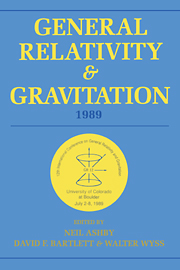 General Relativity and Gravitation, 1989
General Relativity and Gravitation, 1989 Published online by Cambridge University Press: 05 March 2012
In order to enable serious discussions, to allow the speakers to describe their subject in detail and give self-contained reviews, only three talks were scheduled for the workshop. The other submitted papers which partly contained substantial contributions to quantum field theory in curved space-time and its applications, have been presented to the participants through the abstracts and posters.
Coarse-grained effective action
In many studies of quantum fields in dynamic space-times one often needs to treat the high frequency and the low frequency normal modes differently. One familiar example in early universe quantum processes is in the cosmological particle creation backreaction problem (Lukash and Starobinsky (1974); Hu and Parker (1978)), where a division is made at the non-adiabatic limit for each mode to distinguish (quantum) particle creation from (classical) red-shifting effects. Another is the recently proposed stochastic inflation model where a cut-off of the fluctuation field momenta at the horizon introduces a Markovian noise source (Starobinsky (1986); Rey (1987)). However, these simple cut-off procedures cannot account for the mixing of high and low frequency modes due to non-linear interaction or nonadiabatic effects.
In his talk B. L. Hu proposed a coarse-grained effective action for these problems. Most work on coarse-grained free energy is done in critical phenomena physics carried out by condensed matter physicists. After briefly covering these approaches, B. L. Hu turned to his work done in collaboration with Yuhong Zhang.
To save this book to your Kindle, first ensure [email protected] is added to your Approved Personal Document E-mail List under your Personal Document Settings on the Manage Your Content and Devices page of your Amazon account. Then enter the ‘name’ part of your Kindle email address below. Find out more about saving to your Kindle.
Note you can select to save to either the @free.kindle.com or @kindle.com variations. ‘@free.kindle.com’ emails are free but can only be saved to your device when it is connected to wi-fi. ‘@kindle.com’ emails can be delivered even when you are not connected to wi-fi, but note that service fees apply.
Find out more about the Kindle Personal Document Service.
To save content items to your account, please confirm that you agree to abide by our usage policies. If this is the first time you use this feature, you will be asked to authorise Cambridge Core to connect with your account. Find out more about saving content to Dropbox.
To save content items to your account, please confirm that you agree to abide by our usage policies. If this is the first time you use this feature, you will be asked to authorise Cambridge Core to connect with your account. Find out more about saving content to Google Drive.